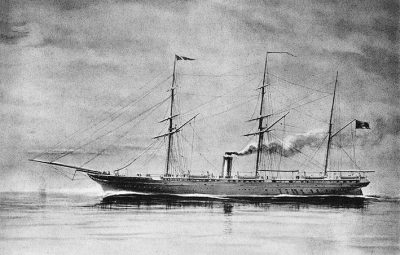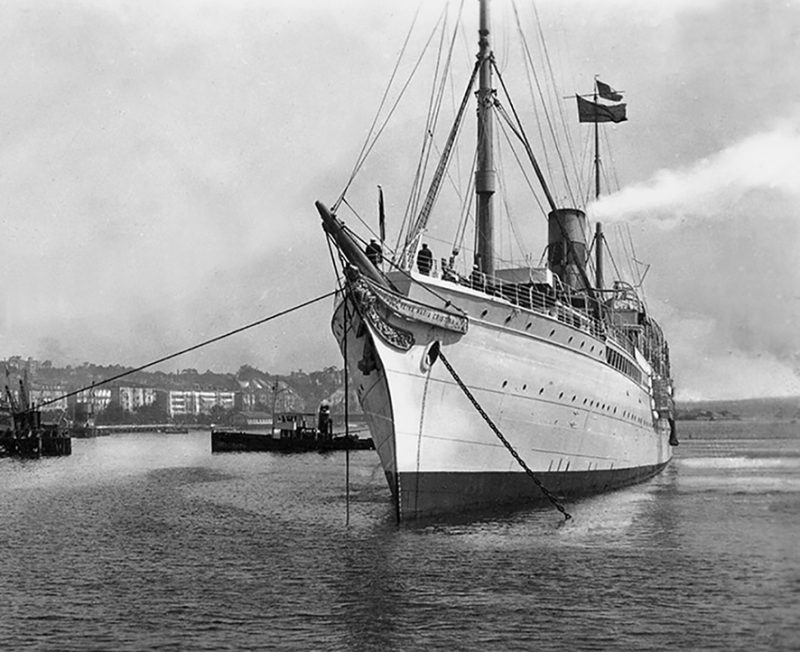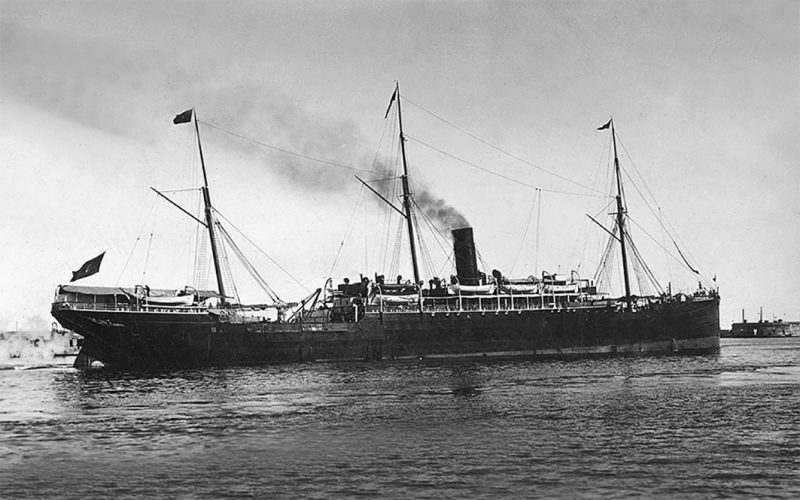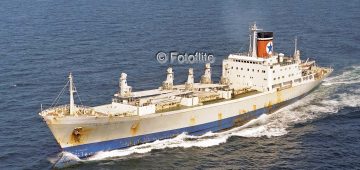The Spanish Line

The Spanish Line was the premier overseas passenger line of Spain and lasted for a period of 162 years from 1850. The history can be traced back to the late 1820s and 1830s when Antonio Lopez y Lopez emigrated to Cuba at the age of twelve years. He had been born in 1817 in the small town of Comillas near Santander, and was followed to Cuba by his brother Claudio. He began trading in dry goods, and made a small fortune, then in 1850 the brothers began shipping dry goods, sugar, rum and molasses around the coast from Santiago and Guantanamo into Havana Bay past the 16th century El Morro fortress. The vessels used were the wooden screw steamer General Armero of 716 tonnes displacement and the wooden paddle steamer Botafuego of 143 grt. The brothers then returned to Alicante in 1856 to set up a shipping company, Antonio Lopez y Compania, which began an Alicante to Marseille passenger service with three small Denny built ships, Madrid of 715 grt, Alicante of 604grt, and Marsella of 715 grt, to connect with newly opened railway lines.
The ambition of the brothers was to start a Transatlantic passenger service, and in 1861 they were awarded a contract by the Spanish Government to carry passengers and mail from Cadiz to Havana, San Juan on Puerto Rico, and Santo Domingo on Hispaniola. They needed well founded passenger liners suitable for long ocean voyages, and placed orders for three ships with William Denny at Dumbarton. However, the service was to begin in early 1862, and they were forced to purchase nine second hand steamers to begin the service while awaiting the new ships. This trio of iron hulled three masted steamers of 1,950 grt would be equipped with four tubular boilers and direct acting steam engines to give a service speed of twelve knots.
The trio were barque rigged and able to carry two hundred First Class and fifty Second Class passengers. The first pair were delivered in May and September 1863 as Principe Alfonso and Infanta Isabel at a cost of £103,180 for the pair, including deduction of a penalty of £1,250 for late delivery by the shipbuilder and for deficiencies in the spare gear and engines. There was a profit of £2,075 for the shipbuilder, who launched the third ship as A. Lopez on 21st November 1865, all of the trio having dimensions of length 282.0 feet and moulded beam of 38.5 feet. The design of the third vessel was altered to halve her cargo spaces in order to carry 620 steerage passengers.
The service prospered as the trio were equipped with two 32 pounder guns as a precaution against pirates in the Caribbean. The next ship was completed as Mendez Nunez in December 1870 by Robert Napier at Glasgow, and was fifteen feet longer than the original trio and of 2,331 grt. Similar sized ships were built by Oswald and by Pile on the Wear and by Dudgeon on the Thames in 1872. The next pair of Clyde built ships were completed in 1875 and 1878 and marked a step up in size to just over 3,000 grt as Alfonso XII, the then King of Spain who reigned between 1874 and 1885, and Ciudad de Cadiz.
The company moved its base from Alicante to Barcelona in 1881 and changed its name to a limited company, Compania Trasatlantica S.A. However, expansion plans for a service to Manila in the Philippines, where Antonio Lopez also had interests, had to be put on hold as the award of the Eastern Royal Mail contract went to their business rival, the Marques de Campo, a wealthy banker. The latter owned no ships, but quickly purchased British India Line and Castle Line passenger liners to establish the eastern route via the Suez Canal.

Antonio Lopez had been given the title of Marquess de Comillas in 1878, and to avoid using Marques de Campo ships he founded the Compania General de Tabacos de Filipinos in November 1881 to transport cargo home from the Philippines. However, after four years of heavy losses, the Marques de Campo was forced to sell his fleet to Claudio Lopez Bru (1853-1925), second son of Antonio Lopez, who had died in January 1883 of pneumonia. The first son of the founder had also already died, the founder having married Lluisa Bru y Lassus.
Claudio Lopez Bru inherited the title of Marques de Comillas in 1883 and all of the business interests of his father, and then began building up the fleet, purchasing eighteen vessels in 1884, including seven from the bankrupt Marques de Campo fleet. The company now held the mail contracts to Cuba, Puerto Rico, Santo Domingo and the Philippines. A new service to Central and South America was begun in 1886, with Antonio Lopez 3,460/81 as the first company ship with a steel hull and the first with electricity for lighting when completed by Denny in 1887.

British yards then completed five fine new passenger liners for the Spanish Line during 1887/89, including the twin funnelled Alfonso XII (2) from the Wigham Richardson yard on the Tyne, and the single funnelled Alfonso XIII (who reigned between 1886 and 1931), Reina Maria Cristina, Monte Video and Buenos Aires. Some vessels of this quintet had great longevity, with Monte Video and Buenos Aires lasting 52 years before going to the breakers yards in 1940. Reina Maria Cristina was the exact twin of Alfonso XIII and named for the wife of King Alfonso XII, who after his death was known as ‘The Happy Widow’. This ship became a white hulled cruise ship in 1926 with her masts now reduced to two only, and along with the cruise ship Manuel Arnus, brought American tourists from New York to Seville to include visits to the great attractions of Madrid, Toledo, El Escorial, Granada and Cordoba. The cruise ships were given yellow funnels with two red bands and not too dissimilar to Compania Trasmediterranea. The Caribbean services were extended to Mexico in the 1890s, and a feeder service was begun between Havana and New York. By 1894, the company had a big fleet of 33 vessels of 93,500 grt engaged on Transatlantic services.

Subscribe today to read the full article!
Simply click below to subscribe and not only read the full article instantly, but gain unparalleled access to the specialist magazine for shipping enthusiasts.






Comments
Sorry, comments are closed for this item